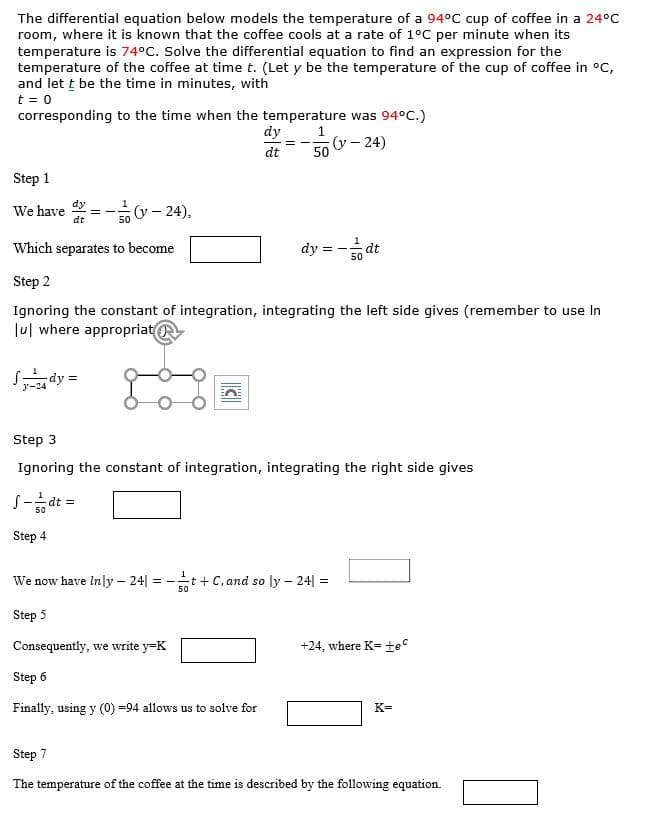The differential equation below models the temperature of a 94°C cup of coffee in a 24°C room, where it is known that the coffee cools at a rate of 1°C per minute when its temperature is 74°C. Solve the differential equation to find an expression for the temperature of the coffee at time t. (Let y be the temperature of the cup of coffee in °C, and let t be the time in minutes, with t = 0 corresponding to the time when the temperature was 94°C.) 1 dy (y- 24) dt 50 Step 1 dy We have dt (y-24), 50 Which separates to become dy = -dt Step 2 Ignoring the constant of integration, integrating the left side gives (remember to use In Ju| where appropriat S dy = y-24 Step 3 Ignoring the constant of integration, integrating the right side gives Sat = dt3D 50 Step 4 We now have Inly - 24| = -t + C.and so ly – 24| = 50 Step 5 Consequently, we write y-K +24, where K- te Step 6 Finally, using y (0) -94 allows us to solve for K- Step 7 The temperature of the coffee at the time is described by the following equation.
The differential equation below models the temperature of a 94°C cup of coffee in a 24°C room, where it is known that the coffee cools at a rate of 1°C per minute when its temperature is 74°C. Solve the differential equation to find an expression for the temperature of the coffee at time t. (Let y be the temperature of the cup of coffee in °C, and let t be the time in minutes, with t = 0 corresponding to the time when the temperature was 94°C.) 1 dy (y- 24) dt 50 Step 1 dy We have dt (y-24), 50 Which separates to become dy = -dt Step 2 Ignoring the constant of integration, integrating the left side gives (remember to use In Ju| where appropriat S dy = y-24 Step 3 Ignoring the constant of integration, integrating the right side gives Sat = dt3D 50 Step 4 We now have Inly - 24| = -t + C.and so ly – 24| = 50 Step 5 Consequently, we write y-K +24, where K- te Step 6 Finally, using y (0) -94 allows us to solve for K- Step 7 The temperature of the coffee at the time is described by the following equation.
Chapter6: Exponential And Logarithmic Functions
Section6.1: Exponential Functions
Problem 60SE: The formula for the amount A in an investmentaccount with a nominal interest rate r at any timet is...
Related questions
Question

Transcribed Image Text:The differential equation below models the temperature of a 94°C cup of coffee in a 24°C
room, where it is known that the coffee cools at a rate of 1°C per minute when its
temperature is 74°C. Solve the differential equation to find an expression for the
temperature of the coffee at time t. (Let y be the temperature of the cup of coffee in °C,
and let t be the time in minutes, with
t = 0
corresponding to the time when the temperature was 94°C.)
1
dy
(y- 24)
dt
50
Step 1
dy
We have
dt
(y-24),
50
Which separates to become
dy = -dt
Step 2
Ignoring the constant of integration, integrating the left side gives (remember to use In
Ju| where appropriat
S dy =
y-24
Step 3
Ignoring the constant of integration, integrating the right side gives
Sat =
dt3D
50
Step 4
We now have Inly - 24| = -t + C.and so ly – 24| =
50
Step 5
Consequently, we write y-K
+24, where K- te
Step 6
Finally, using y (0) -94 allows us to solve for
K-
Step 7
The temperature of the coffee at the time is described by the following equation.
Expert Solution
This question has been solved!
Explore an expertly crafted, step-by-step solution for a thorough understanding of key concepts.
This is a popular solution!
Trending now
This is a popular solution!
Step by step
Solved in 3 steps with 3 images

Knowledge Booster
Learn more about
Need a deep-dive on the concept behind this application? Look no further. Learn more about this topic, calculus and related others by exploring similar questions and additional content below.Recommended textbooks for you


Linear Algebra: A Modern Introduction
Algebra
ISBN:
9781285463247
Author:
David Poole
Publisher:
Cengage Learning

Algebra & Trigonometry with Analytic Geometry
Algebra
ISBN:
9781133382119
Author:
Swokowski
Publisher:
Cengage


Linear Algebra: A Modern Introduction
Algebra
ISBN:
9781285463247
Author:
David Poole
Publisher:
Cengage Learning

Algebra & Trigonometry with Analytic Geometry
Algebra
ISBN:
9781133382119
Author:
Swokowski
Publisher:
Cengage